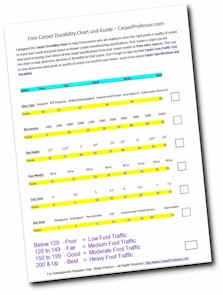How To Choose New Flooring Like A Pro!
Carpet | Pad | Installation | LVP | Forms | Best Dealers
Carpet Specifications
Face Weight, Pile Density, Tuft Twist
|
Best Carpet Near Me? CarpetDealersSee My List |
Why Buy Carpet Made of Nylon?
Nylon is the most durable and most resilient fiber on the market today. Carpets made from Nylon are generally more capable of tolerating medium to heavy-traffic applications.
There are many different grades of the Nylon Fiber and you need to learn what they are and what it means to your own unique application. If you have moderate to heavy foot traffic in your home, then I suggest you select a carpet made of NYLON!
Q. Why Do Carpet Retailers and Carpet Salespeople PUSH Polyester Carpets?
Polyester & P.E.T. Polyester are among the "cheapest to manufacture" which is often why manufacturers, carpet retailers and carpet salespeople work so hard to convince homeowners to buy it.
When you buy a carpet made of Polyester... It translates into more profit for the carpet dealer, for the carpet manufacturer and even higher commissions for the carpet salesperson too! If you want a more durable carpet, choose a carpet made of Nylon!
The Carpet "Specification" Label
On the back of every retail Carpet Sample there should be a manufacturer's label that reveals the Carpet Specifications including:
-
The Fiber Type
-
The Pile Density
-
The Face-Weight
-
The Pile Height
-
The Tuft Twist
These five carpet specifications are the need-to-know information that every homeowner needs to help determine how durable the carpet is; to help determine the carpet's overall value and durability; to determine whether or not the carpet selected would be a suitable choice to meet or exceed your needs, goals, lifestyle and budget based on your own unique level of foot-traffic you have in YOUR home.
Take my Free Carpet Foot Traffic Test to help determine your own level of foot-traffic.
There should be other facts on the manufacturer's label:
-
The manufacturer's brand name (e.g., Shaw, Mohawk);
-
The Carpet style name (e.g., Enchanted Evening II);
-
The color name or color number (e.g., Emerald Forest Green or EFG-124).
-
The type or brand of anti-stain treatments that have been applied (e.g., Scotchgard, Duratech);
If the specification label is missing, or does not provide all the detailed carpet information you need, then you need to ask the salesperson to provide you with a "Carpet Spec Sheet".
This is usually a one-page report provided from the carpet manufacturer that shows all the carpet manufacturing specifications regarding the carpet in question.
Don't be afraid to ask! You have every right to ask for, and obtain all the manufacturing specifications of the carpet you are interested in purchasing. Don't take NO for an answer!
The carpet salesperson may have to call the manufacturer to request it, or call their local carpet mill representative to request the carpet specifications you need. If this is the case, be patient, it may take a couple of days to obtain the carpet specifications you request.
Most homeowners never ask for carpet specs and you will be among the few that do. Most homeowners buy new carpet based on color, style, softness and price. You don't want to do that. Ask for a spec sheet! If they refuse to provide it, then I suggest you shop elsewhere!
You want to make your purchase based on the carpet's ability to perform well over the period of time you require, as well as to choose the color and style you prefer.
Carpet cost should never be the main consideration if you want your new carpet to last as long as possible and be able to handle your level of foot-traffic.
Q. The Salesperson Says Carpet Specifications are not available!
This is not true! There's only one carpet manufacturer that I have ever known to refuse to provide carpet specifications to their dealers and to homeowners, and that mill is Karastan.
All other carpet makers are willing to provide carpet specifications to their dealers; and often to homeowners directly either by phone, by fax, snail mail, email or on the internet. You may need to be patient and give the salesperson sufficient time to call and get the information for you. (It may take a few days)
Need Carpet Specs? Call The Manufacturer Yourself!
If your carpet salesperson refuses to obtain all the carpet specifications you need, then you might want to shop elsewhere. You can also call the carpet mill yourself and ask for the carpet specs as long as you have the manufacturer's brand name and the carpet style name. Here is my List of Carpet Mill Websites and their phone numbers.
How is Carpet Graded?
Carpet is graded by the quality and configuration of the materials used including; the Fiber Type; the Fiber Face-Weight; the Tuft Twist Rating; the Pile Density Rating; the Pile Height; and how well it is constructed overall (Including Dye methods; Backing systems; and Manufacturing processes). Determining which carpet is the absolute best choice for a particular application can be quite difficult for even a seasoned carpet professional.
Choosing the Right Carpet Fiber
The most critical factor for every homeowner to consider is the Fiber Type. I have created a detailed page that covers everything you need to know about Carpet Fibers, Nylon, Sorona®, Polyester Smartstrand®, Stainmaster®.
Pile Density Rating is the Key to Carpet Durability
The Density rating is determined by pile yarn weight, pile thickness and pile height. Think of it like a densely wooded forest where the trees are thick and packed closely together.
Dig your fingers into the pile of the carpet. Are the fibers tightly packed or can you easily see the carpet backing? The more densely the tufts are packed together the more durable the carpet will be. Pile Density is the key to having a carpet retain its like-new appearance longer.
Pile Density ratings range from 1000 to 6000 and is determined using a mathematical formula based on the Pile Height and the Fiber Face-weight.
Here is the formula:
Fiber Face-Weight x 36, divided by pile height (in decimal form) = Pile Density.
For example, a 35 ounce face weight carpet with a half inch pile height would have a pile density rating of 2520 (35 x 36 divided by .5 = 2520).
Take my free carpet foot traffic test to see what grade of carpet may be best for your application and foot traffic level. Take my Free Carpet Foot Traffic Test
What is Carpet Face-Weight?
Face-weight is the actual weight of the fiber used to manufacture the carpet pile, but does not include the weight of the carpet backing. Fiber Face-weight is not the same as Total Carpet Weight, which includes the weight of the carpet backing and the fiber face-weight.
Most carpets have a face-weight between 20 ounces and 100 ounces, but the average face weight for a residential carpet is about 45 ounces.
A higher face weight does not automatically mean the carpet is a better grade; is a higher quality; is more durable; or is more costly. Pile Density is the most important factor next to Fiber Type.
What is Carpet Pile Height?
The Pile Height measurement is not usually shown on the carpet sample, however all you need is a tape measure to determine a close guess. I generally recommend a pile height of less than 3/4" to help reduce the chance of matting and crushing of the pile.
What is the Carpet Tuft-Twist Rating?
The Tuft Twist is a major key to having your carpet retain its like-new appearance longer.
With plush styles of carpets, the tufts of fibers are twisted in the same way that people curl their hair. The carpet fibers are grouped together into tufts and twisted while heat is applied to "set" the fibers permanently, hence the term "heat set".
Carpet fiber, also called yarn, is either extruded or twisted to form a single strand or "filament", These filaments are similar in size to a human hair. A bunch of filaments are grouped together and twisted together to form Tufts. While the strands are twisted, heat is applied to "set" them permanently, hence the term "heat set".
This is very similar to the way women might use a curling iron to create curls in their hairstyles. The tighter the tufts are twisted together, the more durable the carpet will be, and the longer the carpet can maintain its like-new appearance.
![]()
This tuft has 7 twists and is a sign of a well-made, more durable carpet.
Frieze styles have tufts similar to this.
![]()
This tuft has 4 twists and is not as durable. This is a sign of a lower-grade carpet. Inexpensive Plush and Textured Plush styles often have tufts similar to this.
The Number of Tuft Twists is an important key to making sure your carpet retains its like new appearance longer. Frieze styles tend to have a higher tuft twist (over 6) and is why they are well-known for their durability and retaining a like-new appearance longer than many other styles.
-
The Tuft Twist Rating is based on the number of twists per lineal inch of the tuft.
-
The Tuft Twist numbers usually range from 3.0 to 7.5
Why Carpet Tuft-Twist Rating Matters
Carpets
with a low Tuft Twist Rating (3 to 5) tend to untwist or “blossom” at the tuft tips more quickly, thus creating a worn out, frizzy looking or
matted down appearance.
at the tuft tips more quickly, thus creating a worn out, frizzy looking or
matted down appearance.
Carpets seldom wear out from the loss of fiber, they just start to mat down; gradually lose the luster and shine; and just start to look bad.
Once the tufts have blossomed and become matted down, it cannot be reversed. For this reason a Carpet with a higher Tuft-Twist (5.5 to 7.5) will retain its like-new appearance longer and tolerate a higher level of foot traffic.
When comparing similar quality carpets side by side, you must consider the tuft twist rating to help you determine which carpet is the better choice.
Carpets with a lower tuft twist rating tend to "blossom" more quickly and as a result will be less durable and will appear word out sooner.
Free Carpet Durability Guide Chart
Use my Carpet Durability Chart to better understand how carpet durability is determined in part by the number of twists each tuft has.
Frieze styles typically have a very high tuft twist rating of at least 6 or more.
That's the main reason why Frieze style carpets tend to wear better and last longer than many other carpet styles.
Learn more:




